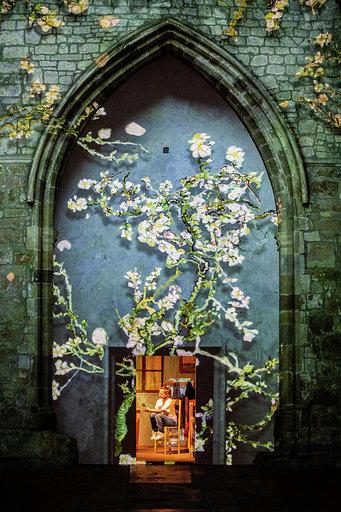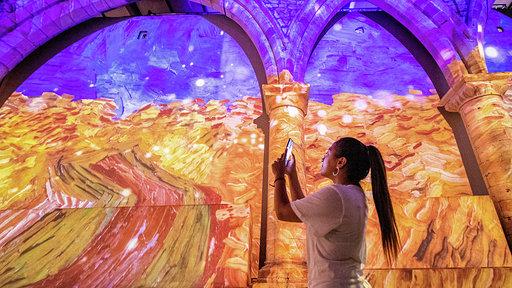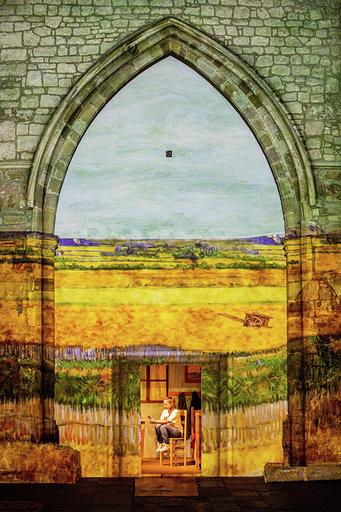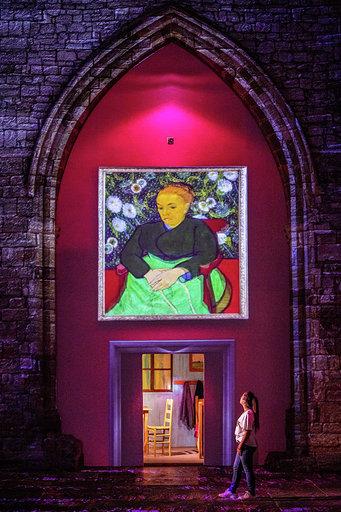
VAN Gogh: The Immersive Experience is to be given an extended run at York St Mary’s, having drawn 50,000 visitors since July.
The Vincent Van Gogh exhibition was set to close on January 5 but now will be open until the end of the Easter holidays on April 19.
Explaining the decision, creative director Mario Iacampo said: “We have had such a warm welcome in York, and incredibly positive feedback about how people have been moved by the experience, so we’re delighted that we’re able to continue as a part of York’s vibrant winter programme of events and activities.

“York St Mary’s is a wonderful venue for this kind of immersive digital art: right in the heart of the city for easy access, yet able to be adapted, so visitors feel as though they are in the French countryside, or overlooking the Rhone, during their time with us.”
The multimedia experience centres around a 360-degree projection in the nave of the deconsecrated church, making use of the stone arches and high ceiling. Animated versions of more than 200 of Van Gogh’s most famous works are projected on to the walls, while a specially written emotive soundtrack and relaxing reclined deckchairs encourage visitors to sink into the environment around them for a Zen-like experience.
The main show runs on a continuous loop lasting 35 minutes, and visitors can spend as much time as they want in the nave.

At the end of a visit, a virtual reality experience takes visitors through a day in the life of the artist in Arles during Van Gogh’s time there, depicting locations that inspired his work, starting with the bedroom in the farmhouse that he painted three times.
Paul Whiting, head of marketing and communications at Visit York, said: “We’re delighted that this innovative exhibition will be extended into 2020. It’s a wonderful addition to the media arts offering of the city, combining a beautiful, atmospheric venue with a uniquely immersive art installation. It’s great news that visitors and residents will have further opportunities next year as they enjoy their ‘Only in York’ experience.”
Van Gogh: The Immersive Experience, at York St Mary’s, Castlegate, York, will be open from Wednesday to Sunday in January, February and March, daily during half term and then from March 30 until April 19.
Admission prices are £13, £11, concessions, and £9, children, with booking strongly recommended. For more details and opening times, visit vangoghexpo.co.uk.

Here is Charles Hutchinson’s feature on Van Gogh: The Immersive Experience, as first printed in The Press, York, on July 15.
WHAT is the difference between an exhibition, a show and an immersive experience, like the one you can encounter at York St Mary’s?
Let Mario Iacampo, the man behind the cutting-edge Van Gogh attraction in Castlegate, York, define it.
“Van Gogh: The Immersive Experience is not an exhibition and it’s not a show, which I believe requires a live element; it’s somewhere between the two,” he says. “I wanted to create a Zen environment where you can sit down and watch at your leisure.
“To make it an ‘experience’, first of all there has to be emotion; then there has to be music to go with it; thirdly, there has to be the immersive experience, all around you, even on the floor.”

Iacampo, the creative director and founder of Exhibition Hub, has worked with animation artists at Dirty Monitor to create the 360-degrees digital art installation of 19th century Dutch artist Vincent Van Gogh’s paintings evoking his life story.
Having drawn 82,000 people in Naples and 150,000 in Brussels, it is making its British debut in York, Britain’s first UNESCO City of Media Arts, where it will be on show until January 5 2020.
Why did you choose York, Mario? “We were looking at venues around the UK for a while, and I like to present the ‘experience’ in historical buildings,” he recalls. “We went to the Council of Churches and we started studying possibilities.
“York has a huge number of tourists coming to the city, and it’s placed in the middle of the country, which is why we thought York would work well.

“Then the history adds to the impact of the presentation, and using the columns and alcoves of the church are a big part of the interpretation. York St Mary’s was ideal.”
Nine months of preparation and a fortnight of construction then went into making the York installation. After adapting the technology to the 3D design of the York church – the building has four alcoves, compared to six in Naples – the immersive experience projects animated displays on to the walls of the former St Mary’s Church, where black-out blinds and a dozen projectors have transformed the normally light and airy building into a constantly moving projected gallery of 200 of Vincent Van Gogh’s most famous 19th century works.
At one end is a re-creation of Van Gogh’s bedroom in Arles, the subject of three of his paintings with its cramped bed, two chairs, yellowed window, battered Panama hat and row of jackets.
The central Nave houses a 35-minute immersive display, with a carpeted floor filled with deckchairs, from where visitors can enjoy the 360-degree displays seated, standing up or even lying down as the images move over the walls and floor – and their bodies, should they be horizontal.

Rather than merely projecting the original paintings, the immersive experience provides the twist of digitally animating the works: wheat sways in the breeze, water pours out of the confines of the painting’s frame, and the stars twirl and swirl in the night sky. Spookily, a skeleton suddenly smokes a cigarette. Steam from a train gradually immerses all the walls.
Everything comes alive all around you: the sun’s ever-changing position will lead to ever-changing shadows on the walls. There is so much to take in, visually, orally too, that you will want to stay longer than the 35-minute installation loop. At £13, make the very most of an artistic experience like no other in York previously.
The immersive experience is divided into, or rather flows seamlessly through, three sections: his painting years at Arles; his family, showing the repetitions in his portraits; and his years in the asylum in Saint-Rémy-de-Provence, 18 miles from Arles, still prolific years, but troubled by mental illness, ending in his suicide. The moment his self-portrait with his bandaged head suddenly emerges on the wall shocks anew.
For an extra £3, you can experience a 12-minute Virtual Reality rollercoaster ride from Van Gogh’s house to the settings of his best known works. Breathtaking. Truly breathtaking. And what’s more, part of the money raised from the VR experience will be donated to SASH, the York charity for the homeless, at Mario’s request.

“Sadness will last forever,” says one of Van Gogh’s quotes liberally sprinkled around St Mary’s, yet Mario points out: “He committed himself to the asylum because he felt he needed help, but he was also extremely prolific during that time, and they’re not all sad. Yes, there are some dark works, but he also painted what he saw around him, the gardens, what people were doing.”
Why did he pick Van Gogh for an immersive experience, rather than, say, Picasso or Dali? “You have to choose an artist whose paintings are ‘filled in’ with colour. You put up Starry Night and it fills the building. It really ‘pops’ into life.
“It’s the same with Monet, who we’ve also done for an immersive experience. You could do the same with Dali, but Picasso, maybe not,” says Mario.
“You also choose an artist that people understand, as you’re creating an experience for the general public, not for academics, though they have been complimentary. “ Van Gogh’s profusion of letters, 844 of them, primarily to his younger brother Theo, have helped hugely with the psychological aspect of the experience, cutting out the need for guesswork in interpreting his works. “It’s much easier when you have those letters, says Mario.
Van Gogh, by the way, signed his paintings “Vincent” for “the simple reason” no-one could pronounce his surname.
For the record, Mario pronounces it Van Goch, as in clock.
